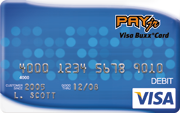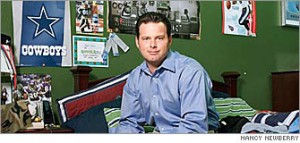 Seeing as how we’re smack dab in the “final 48 hour retail frenzy” of credit card-flinging shoppers at risk of losing every logical brain cell, my interview with PAYjr Founder/CEO David Jones (merged w/PAYjr Visa Buxx) is timely.
Seeing as how we’re smack dab in the “final 48 hour retail frenzy” of credit card-flinging shoppers at risk of losing every logical brain cell, my interview with PAYjr Founder/CEO David Jones (merged w/PAYjr Visa Buxx) is timely.
Parents’ pockets are being picked as we speak, and it’s not always about ‘taming the holiday gimmes’…Eager-to-please youth are often flailing in ‘Can I borrow or get an advance?” mode for gifting someone special…(might even be YOU!)
So what’s a rational, pragmatic approach to rein in a consumption-driven American culture that spends $250 billion every year on gifts; besides an abstinence-based, ‘just say no’ approach to managing fiscal fitness?
How can kids learn lessons from the nation’s debt binge most effectively?
 Last month when I wrote about the Dangers of Debt Cartoon Contest from Consumers Union, I received an outpouring of head nodding and wails of ‘unfair’ from students in debt, parents feeling duped, and earnest credit card execs feeling they’re scapegoats for financial literacy and parental controls that are sorely lacking…
Last month when I wrote about the Dangers of Debt Cartoon Contest from Consumers Union, I received an outpouring of head nodding and wails of ‘unfair’ from students in debt, parents feeling duped, and earnest credit card execs feeling they’re scapegoats for financial literacy and parental controls that are sorely lacking…
In short, I whacked the proverbial hornet’s nest as usual, and the buzz has brought out some insights that should be shared universally.
So without further ado, here’s my interview with David Jones, representing both PAYjr and Visa Buxx programs, along with a few prequel disclosures you should be aware of in advance…(I wish the banks and cards were this clear!)
1.) Though I don’t personally know PAYjr’s David Jones, (at left, photo by Nancy Newberry, Inc.com) his candor and tolerance putting up with my quite prickly questions is appreciated.
In fact, his willingness to jump right in, share his point of view and help clarify detours and perceptions on prepaid policy, products and parenting is a textbook case of CEO access and accountability that didn’t mask as lipservice. So if it seems like I was ‘grilling him’ that leads me to disclosure #2.
2.) I was one of the early branding/marketing agency consultants brought in on Visa Buxx when they were a ‘glimmer in the eye’ long ago. I was keen on instilling financial education to kids, but was heavily disappointed the program didn’t receive the marketing ‘oompf’ it deserved to rollout and make a difference; so no sour grapes, but no sparkling toast to a job well done either. I felt like Visa Buxx had the bucks to really teach kids some savvy money management, so this was my opportunity to deconstruct ‘what happened’ and cut through the fluff and spin. David knew my background at the onset, with promises of fair but firm blunt questions.
3.) Finally, there are two age divisions and differentiators within the PAYjr/Visa Buxx product lines that need clearly called out from the get-go: The online PAYjr Chores & Allowance program (age 12 and under) is FREE…The PAYjr Visa Buxx card (13+) has monthly service fees, activation fee, and reloading fees involved…
 Neither one is a ‘Visa credit card’…It may look like one and act like one, but it ISN’T one!!
Neither one is a ‘Visa credit card’…It may look like one and act like one, but it ISN’T one!!
PAYjr prepaid Visa Buxx has the teen caché of autonomy and Visa functionality and for off-the-chart über-cool premium presentation, it’s the only customizable teen offering (photo uploads by the teen)
FAQ here for time-crunched parents and last-minute shoppers…
So…first the global questions: Are prepaid plastic cards for kids financial training wheels or habit-setting for a cashless culture? Or both? Have checks and cash become obsolete in 21st century digital commerce? Will credit cards falter? What do YOU use the most in your world, and how?
Shaping Youth’s Amy Jussel & PAYjr’s David Jones Discuss Prepaid Plastic for Kids
Part One: PAYjr’s Visa Buxx (13+)
Shaping Youth: You mentioned it feels unfair to be portrayed as a “big bad credit card company trying to take advantage of parents and kids” —how do you differentiate between financial literacy and corporate branding?
David Jones: I’ll be candid here, my goal when I started was not to teach kids financial literacy. My background is creating new consumer payment products and I saw there was a need for electronic allowance because less and less parents are carrying cash and I realized that teens were wanting to spend money online without the tools to do so.
Financial literacy, in my mind, is a byproduct of experience and therefore it is a byproduct of my product, a good one. Teens are not going to sit down and read materials about this, but what we are trying to do is create a tool that parents and teens will find useful in transacting commerce and hopefully as a result, they become better at managing money before they are on their own.
- I’m not a non-profit and I’m certainly not an expert in teaching kids financial literacy. But I am also not a credit card company trying to take advantage of our youth.
- I am an entrepreneur trying to fill a real need that both teens and parents have and if I can do some good along the way, great!
My company has 14 people, we struggle to make payroll week after week. I took a large pay cut to run this company and the people working here are passionate about building a great product. The idea that we are backed by or part of some big conspiracy to brainwash teens into using credit cards is just ridiculous.
This has been a labor of love and many times, we could have taken the low road and chosen to charge fees like others do; and maybe today we would have a more successful business but I don’t do business that way and ultimately, I believe that the community and society recognizes well intentioned businesses.
Shaping Youth: Is it unfair to say that preventive education by credit card companies is discordant?
David Jones: It is not unfair to say that banks and credit card companies and providing lip service when they say they care about preventive education.
The fact that out of 10,000 banks and credit unions, that less than 50 have a teen prepaid card, is proof enough that there is no true desire to educate teens on financial management.
Banks and credit unions should would wake up and realize that these teenagers are their future and that they should be offering these financial literacy and transaction tools at no cost today as an investment in a relationship for the future. They don’t offer the programs because they don’t make them money…it is as simple as that.
Shaping Youth: In your opinion, where does Corporate Social Responsibility (CSR) end and commercialism and brandwashing begin??
(Example: Nickelodeon/Capitol One’s sponsorship of ‘Budgeting: A Day in the Life of a Parent’ which teaches kids NOT to beg for products, shows kids how to understand the concept of limited resources etc. versus their outright sponsorship of high school signage and/or aggressive marketing of their product—is there a difference?
David Jones: I’m such a liberal socially but this may sound counter to that belief. I think that consumers as a whole have to make that call. Corporations should not be forced into social responsibility.
There are businesses run by people who may be more social responsible than others and they may do more than the next and I think that is great but there should be no requirement on businesses other than that. A company is set up to make money for its shareholders and that is and should be its only responsibility.
Now, if the only way for that company to make money is to create a good persona in the community by being socially responsible, then certainly they must react to that requirement but that is market driven.
Having said that, we as consumers have a voice and it is our pocket books. I would be disgusted if Capital One advertised to my kids at school and frankly I don’t believe that schools should have the right to do that. It seems like once a month, my kids come home with a product that is being pushed by the school; the latest one has been “speed stackers,” plastic cups that sell for $15 and because the school has been pushing it, it is hard for me to say no as a parent.
Schools are not a place for advertising and product pushing, they are a place for learning. We as parents have a responsibility to hold our schools and officials responsible for things like this, but I cannot blame the companies for trying.
Shaping Youth: Could you explain the specific costs involved, age appropriateness, and differentiation between PAYjr and VisaBuxx and other prepaid cards on the market?
Also, what ethical caveats do you feel are ‘inbounds or out of bounds’ in terms of ‘mining’ the brands: a.) in schools b.) in colleges c.) in families/homes via low interest financing on cars, mortgages, goods and services?
David Jones: The PAYjr program is for kids age 12 and under; there is no cost to the program today, but we are also not providing a “card” today.
We had piloted with Target earlier this year a Target Gift Card, that would be loaded as the child earned money but this limited the child to spending their allowance at Target. It was always our intent to build a card, that would be parentally controlled and that could be used at a variety of locations that a child might want to spend their allowance. Places like iTunes, NeoPets, Lego.com, Club Penguin, etc. This is still a goal of ours but given the economic climate for venture capital, we have had to put this part of our program on hold due to resource constraints.
Today, the PAYjr program is nothing more than a useful online chore system with over 100,000 families using the tool; we’ll evolve this tool in the future.
The Visa Buxx program (www.Buxx.com) is our prepaid teen card for teens age 13 and up. There are only a handful of true “teen prepaid cards” on the market; Buxx, Allowcard, and Upside. There are a handful of banks offering Visa Buxx, similar to our Buxx program and many of these banks are using us behind the scenes to provide the service.
Our main differentiator is providing the ability to customize the Visa Buxx cards with a picture, art, graphics, etc. We are the only one in the teen market with this capability today. (Our primary business is actually Card Lab and our custom Visa Gift Card — www.GiftCardLab.com)
I also like to believe that our pricing is more upfront and fair. I would say Allowcard is the same way but Upside, in my view, is taking advantage of teens.
- The primary reason we built this program was to prevent teens from being taken advantage of by banks who will gladly charge $25-35 every time a teen goes NSF (insufficient funds) with a check or debt card from a teen account.
- And this is where I start to get frustrated by the media because they typically claim there are “free” teen checking alternatives to our program and they like to point out that our $3.95 monthly fee and $.50/load fees are expensive.
- In reality, a teen will draw his account over balance some 3-5 times per year. Banks will allow this to happen, even with a debit card when they could instead choose to decline the transaction at the point of sale. Then the bank will also collect their $25-35 fee.
Even if there is overdraft protection on the account attached to a parent’s account, banks will charge an “overdraft protection fee”; once again, even though the bank knows at the time of sale, that there is not enough money to cover the purchase. So now, a $1 iTunes song can turn into a $26-36 purchase…
Upside Card, acting very much like the banks, advertises a “No fee” card for students but this is VERY misleading. Yes, Upside does not charge an upfront fee, or a monthly fee or even a load fee for some of its programs but the card is far from being a “No fee” card. When you read the terms and conditions there is a “Decline fee on POS or ATM withdrawal” of $2.
This is even more abusive than what the banks are pulling with the NSF (insufficient funds) fee because the reality is that a single transaction could cost the teen several dollars.
- When you walk up to a point of sale and provide a card and if the card does not get approved, what does the clerk typically do? They try the card again, and perhaps even again…many times by the request of the embarrassed cardholder.
- Each time this card is run, the $2 fee is applied!
Let’s face it, the reality is that it is impossible to supply a teen prepaid card without fees, there is just not enough spending on the cards to pay for the servicing and processing of the cards.
Having said that, we have taken the approach to be upfront with parents and teens and list our fees clearly and openly. Others have taken the abusive approach of hiding fees and taking advantage of the mistakes that we all know teens will make when learning to manage their finances.
This gives our industry a bad name and I think it is part of the reason the industry has not moved forward as fast as it should have.
Shaping Youth: You mentioned PAYjr is limited in terms of where kids can use it in order to yield to parental controls re: adult oriented purchases, gambling, dating, porno and such…which is great, but then you mention that you’re talking about using it in schools for “fundraising?”
If districts are ‘promoting the card’ whether for convenience, fundraising, or as a training tool, this is a commercial venture entering the public education sphere. How do you justify that to critics?
David Jones: I don’t and can’t justify it to critics. It was an early idea we had for marketing the card program and it would be a low-cost method for getting the program in front of lots of parents and teens but we came to the same conclusion you did and have never used schools for marketing our products.
Shaping Youth: What role do you think financial institutions should play in money management and fiscal literacy pertaining to youth?
David Jones: I think they should learn that providing money management and fiscal literacy is a financially smart decision for themselves. They should make investments in this today in order to build relationships with their future generation of account holders. Parents will embrace the service because most parents don’t know how to teach the topic themselves.
Shaping Youth: Are Visa’s ‘personalized’ credit cards a hit? (e.g. the GiftCardLab creations, teens gifting peers using the customized branding, how do the fees vs. fun factor shake out?)
David Jones: Yes, custom cards are a hit. People love the ability to customize and personalize everything these days. I do want to be clear that GiftCardLab is not a youth oriented product, we built GiftCardLab because we learned quickly after launching Buxx.com that parents too wanted custom cards. That is not to say that teens don’t buy gift cards from us but I doubt they do. GiftCardLab is a premium gift card product and targeted towards higher income gift givers, not teens.
Shaping Youth: I realize PAYjr is a prepaid vs. CREDIT card, so there’s no inherent ‘credit score’ being built, but is there a simulation where kids earn a ‘mock credit score’ for inputting data regularly and showing responsibility in keeping up with the use of the tool?
Does PAYjr engage in simulations or have plans for fiscal literacy in virtual worlds like Minyanland or other economic ‘edutainment’ venues?
David Jones: I would love to add things like this, but do not have the budget or resources to do so.
Shaping Youth: What’s your overall opinion (pro/con) on ‘prepaid cards’ for kids to use as financial training tools vs. credit cards that are parent controlled ?
David Jones: I think the pros/cons of that would depend on how closely the parent tracks the activity so its hard to say what the pros and cons of that program might be. For our program, I’d say:
Pros
Electronic means to transfer for funds to teens
Lower cost transaction tool for teens
Parental control and tools available
Cons
Cost more than cash (unless you account for ATM fees)
Card use has a different effect than using cash — people are usually more tempered in their spending with cash
Some locations require IDs, which teens may or may not have — cash works everywhere
Stay tuned for Part Two of the Interview with PAYjr’s CEO David Jones, where he discusses reward systems, parenting, praise and responsibility, and shares his own family’s tips on using the Chores & Allowance online program for 12 & Under…
Meanwhile, teens can take a pre-quiz on financial savvy on their education page, where this stat jumped out at me,
“The number of 18 to 24-year-olds declaring bankruptcy has increased 96% in 10 years.”
Ho-ho-holy moly…
Get a grip on that holiday spending kids. Walk away from the cards…At least the credit ones.
Related Notes/Resources
Dec. 18 Consumers Union.org: New Credit Card Protections Adopted by Feds
Merry Cash Only Christmas (Buffalo News)
Young Americans Learn Budget Basics at Theme Parks (re: Capital One) 11-08
Minyanville: 6 Point Economic Action Plan: Helping Kids Cope (Unemployment)
Minyanville: Do As I Say, Not As I Do: What Savings Lessons Are We Passing Along?
How to Discuss Financial Woes With Children (CreditCards.com/USA Today)
JumpStart Coalition for Financial Literacy
WSJ: Graphic Below: “Credit Card Users Face Higher Fees, Rates” 11-08

![[Credit-Card Users Face Higher Fees]](http://s.wsj.net/public/resources/images/PJ-AN684_pjCRED_NS_20081119220827.gif)








Here’s a new entry from FICA on one of their programs…looks intriguing:
“Future Investor Clubs of America Kids & Teens Programs.
The Future Investor Clubs of America (FICA) founded in January 1997, is a financial intelligence training network designed to introduce students ages 8-19 to the world of finance and business intelligence in a fun and exciting way. Since 1997 thousands have benefited from our training programs and events! FICA is dedicated to “Training Tomorrow’s Investors Today” ™.
The FICA educational training system consist of many exciting and informative special programs/events that include the following:
Future Investor Clubs of America Members Online Network!
Future Investor Clubs Introductory Training!
Wall Street Summer Camps!
Young Investor Clubs!
Young Analyst Clubs!
Young Executives Clubs!
Financial Whiz Kids/Teens Challenge & Competitions!
Whiz Kids/Teens Online e-Learning Network!
Financial Literacy News Online!
International Clubs and Tours!
To learn more Click visit: http://www.ficaworld.com
The Future Investor Clubs of America (FICA) would like to invite you and or students ages 8-19 to become a member of our financial intelligence training network.
As a FICA Member you will enjoy the following benefits:
FICA Club Annual Membership!
FICA Club Prize Drawings!
FICA Club Online Guide!
FICA Club Members Online Training Network!
FICA Club Membership Certificate!
FICA Club *Workshops Invitation
FICA Club *Camps & Conferences Invitation
FICA Club *e-Learning Access Network
To Learn More About Visit Becoming A FICA Member:
http://ficaconnect.com